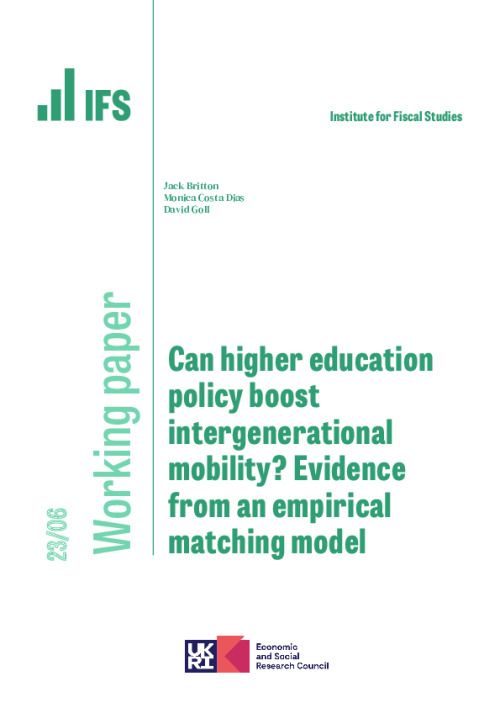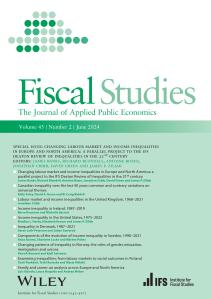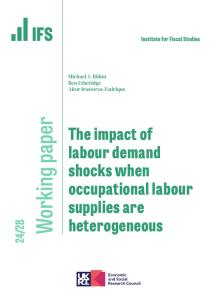The United Kingdom is one of the worst performing countries in the OECD when it comes to “intergenerational mobility”, or the extent to which children’s labour market outcomes are predicted by the income of their parents.
Recent work from the United States (Chetty et al, 2020) concluded that “changing how students are allocated to colleges could substantially increase intergenerational mobility, even without changing colleges’ educational programs.” This is an appealing argument for policymakers, as it implies well-designed policy tweaks could have large payoffs in terms of improving mobility.
The aim of this paper is to better understand which policy tweaks – if any – are likely to yield those increases in mobility in England, while considering some of the potential costs of those policies.1
We do this using an economic model that approximates the way students and universities in England select each other. In the model, students each have their own unique ranking of university degrees that depends on the student’s attributes, the characteristics of the university and subject, and the student’s expected future earnings (which also depend on the university and subject choice and individual student characteristics). On the other side of the market, universities rank students by their test scores and other observable characteristics. Universities weight different test scores differently for depending on the degree subject. In the final step of the model, we use an algorithm to simulate “the match” between students and universities.
To the best of our knowledge, this is the most sophisticated model of the English higher education system to date. We use it to predict the impact of a set of hypothetical reforms to the English system. Since the model is very good at replicating matching patterns seen in the data and is good at predicting how past changes to the system have affected those patterns, we believe it can be informative about the likely impacts of hypothetical reforms to the system. However, while the model is state-of-the-art in many respects, we still must simplify the real-world for it to be workable. Estimates should therefore be taken as illustrative rather than as precise predictions.
With those caveats in mind, our key overall findings are as follows:
- It is difficult for reforms to higher education to affect population-level statistics on intergenerational mobility in the UK. A key driver of this is the very large attainment gaps between richer and poorer students that emerge by the end of secondary school.
- However, there remain substantial gaps in outcomes between students from richer and poorer backgrounds, even when focusing on those with reasonably good prior attainment. For example, those from the top half of the parental SES distribution are predicted to earn 8% more than those from the bottom half by age 40, even amongst high attaining pupils (i.e., those who rank in the top 20% nationally based on their GCSE exam results). Those in the top 20% of the parental distribution are projected to earn 21% more than those in the bottom 20% even amongst those with high attainment.2
- And we find that it is possible for higher education policy to substantially narrow, or even completely remove, these gaps. This result is consistent with the key conclusion of the Chetty et al. (2020) paper cited above, which focusses only on the set of people who attend college in the United States.
Policy simulations
We first assess the following set of “demand side” policies that focus on influencing student choices3 :
Policy 1: Scrapping tuition fees and maintenance loans for low SES students (replacing maintenance support with grants) so that they can leave university debt free.
Policy 2: Increasing cash support for low SES students at university by £5,000 per year while keeping existing tuition and maintenance loans in place.
Policy 3: Like Policy 2 but restricting the extra grant so that it is only available for low SES students studying at “high status” universities.4
Policy 4: Like Policy 2 but restricting the extra grant so that it is only available for low SES students studying LEM (Law, Economics or Management/Business) or STEM (Science, Technology, Engineering or Mathematics) subjects.
We find:
- Policy 1 would affect gaps in participation between richer and poorer students. But it would result in only very small gains in terms of intergenerational mobility, even amongst those who leave school with good prior attainment.
- Policy 2 would have similar effects – it would also narrow participation gaps but not have much effect on mobility. Both Policy 1 and Policy 2 are quite expensive, costing around £1 billion per year5 .
- Policy 3 could substantially reduce gaps in access to top universities between richer and poorer students. But it is not at all effective at improving mobility.
- Policy 4, on the other hand, does move the needle in our simulations. We estimate that grants for studying LEM or STEM subjects would significantly increase participation of poorer students in those areas. It would also cut the earnings gaps between students from high (top 50%) and low (bottom 50%) SES students with high prior attainment from 8% to just 1%, while it would cut the earnings gap between very high (top 20%) and very low (bottom 20%) SES students from 21% to 13%.
- The policy would cost around £750 million per cohort due to the increased spending on up front grants.
- A further tweak to Policy 4 shows that limiting eligibility for the additional subject grants to those with higher prior attainment would reduce the costs by more than half, while preserving most of the benefits in terms of mobility.
Combined, these results suggest that if policy is going to focus on influencing student demand, it would be better focussed on what people study, as opposed to whether or where they study.
Finally, in the most speculative part of the paper, we consider a major “supply side” reform to university admissions:
Policy 5: Forcing universities to give priority admission to low SES students who performed well relative to others in their own secondary school (specifically if they were in the top 10% of their school year based on GCSE results).
- Policy 5 would dramatically reduce gaps in access to top universities and result in major reductions gaps in earnings outcomes. This would reverse earnings gaps between low and high SES students with high prior attainment (from 8% to -5%) and would cut gaps between very rich and very poor students with high prior attainment from 21% to just 6%.
- The policy would involve replacing students from wealthier backgrounds with students from poorer backgrounds with worse prior attainment on average. This would lower overall average earnings overall and hence government revenues from tax and student loan repayments. However, these costs would be quite small, at roughly £75 million per year.
Our work suggests that higher education policy can successfully improve the picture for intergenerational mobility in the UK. It highlights the potential benefits (in terms of mobility) from using cash incentives to encourage students from poorer backgrounds into subject areas that are associated with higher earnings, although this improved mobility would come at a short run cost for the taxpayer. Finally, and most importantly, the paper highlights the potential gains in terms of mobility that could come from aggressive reforms to university admission policies that reduce barriers to access for those coming from poorer backgrounds.











